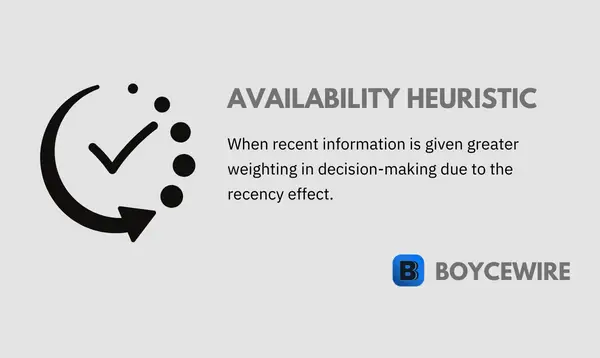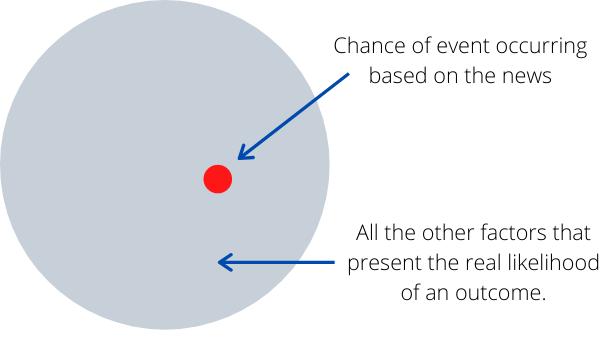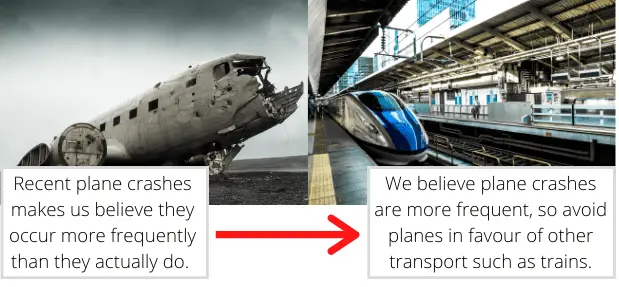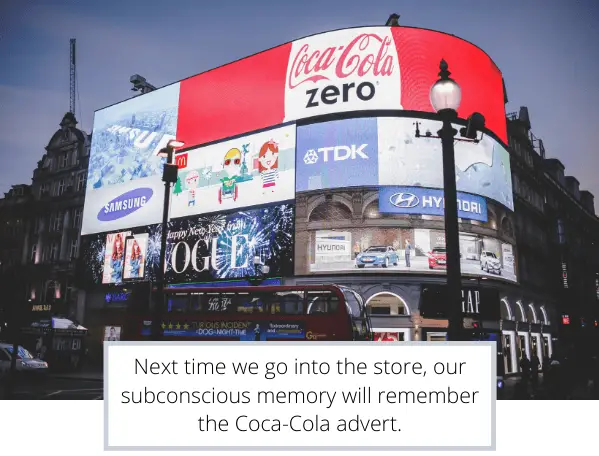Availability Heuristic: Definition & Examples

What is Availability Heuristic
The availability heuristic is where recent memories are given greater significance. They are given greater consideration in decision making due to the recency effect. In other words, because the event is more recent, the perceived chance of it occurring again increase significantly.
One example of availability heuristic is airplane accidents. Often, people hear about horrendous crashes or explosions that kill many people. For example, US air-carrier, Southwest Airlines, experienced a mid-air engine explosion in 2019 that killed a passenger. In the aftermath, the company saw a sharp decline in ticket sales, with the firm losing between $50 million and $100 million in sales. Consumers inflated the expectation of a similar incident far beyond its actual likelihood.
Key Points
- An availability heuristic is a mental shortcut, that helps us understand the world by using information that is easy to recall.
- The availability heuristic is where we take the most recent information and give it greater weighting in our thought process.
- The availability heuristic is a natural phenomenon which aims to try and protect ourselves from recent dangerous events.
In this example, customers assign greater significance to the explosion. Consequently, the expected likelihood of another explosion occurring increases substantially. For instance, the chance of an explosion occurring is 10 million to one. However, due to the recent information, it takes precedence and the perceived risk increases substantially. So, the actual expectation of another explosion may be 100 to one.
Another important factor to consider is that the recent information we digest is only a snapshot of reality. Yet we often do not consider such limitations. Instead, it is often assumed that such recent information provides the whole picture, which, in turn, can result in illogical and irrational decision making. This is also known as the availability heuristic.

Availability Heuristic Explained
The availability heuristic can be split into two parts. Both of which feed into our memories which make the information more accessible:
- What we remember quickly
- What we see
What We Remember Quickly
When asked what you first think of when we say dog, you may think or a traditional idea of a dog. A furry thing with four legs and a tail. That is the availability heuristic. It relies on your sub-conscious memory to obtain information rapidly and instantly. In other words, the information is readily available.
Think of the information as a glass of water on a coffee table. When sitting on the sofa, you can just lean over and grab it. The water is easily available and accessible. This contrasts with having to get up and get some out of the fridge.

Leaning over and grabbing the water from the table is an example of what our brain does. It tries to make life easier for us by grabbing the information that is easiest to recall. After all, nobody gets up from the sofa to grab a glass of water when one is already in front of them.
So when we make a decision, we often think of using information that comes to us most easily. Often, this is driven by recent events. In turn, this can significantly impact our decision making. For example, news of a recent shark attack may put many people off going swimming. Or a recent car accident may put people off driving.
Quite simply, recent events play an important part in our decision as we remember these most vividly. Yet as time wears on, our memory of such events tend to fade, so we place less of an emphasis on such.
What We See
What we see has a crucial impact on our memories and therefore much of the information we see is stored to make it easily available. The more we see an image or other visual stimuli, the more we are likely to remember it. This is often why some students tend to find imagery useful when studying.
If we look at advertisements, for example, they play the same advertisement over and over again. The advertisement may not necessarily be any good, but it’s the consistency that plays into the customer’s brain.
Seeing the same advert every day, we start to become accustomed to it. So when we go to the mall, that memory is stored at the forefront of our mind; whether consciously or subconsciously.
At the same time, the visual stimulus can prove to be an even more effective factor in decision making. For instance, reading about an airplane accident may create temporary panic in one individual which may subside after a few months. However, if the individual was to actually witness that incident, it will likely stick in their mind for many years to come.
Examples of Availability Heuristic
1. Availability Heuristic in Politics
Politics is a prime example of availability heuristic in action. For instance, politicians usually stick to a couple of key areas and nail home their point. Usually, these points will appeal to the masses. Whether it’s immigration, healthcare, or schools.
We’ve seen it time and time again. Politicians promise the public they can fix a problem. They get elected and fail to fix it. However, the next candidate comes along and promises they can. They get elected and equally fail to fix the problem – thereby creating a vicious cycle.
What happens is voters will tend to forget about the unfulfilled promises made by the incumbent. Instead, they hear about the promises from the new candidate, which takes prominence.

Driving the debate
We then have the role of the media and politicians. Combined, they shape the views of the public. For instance, immigration was a key part of President Donald Trump’s election in 2016. Some media criticized the policies, whilst others praised them.
The point to be made is that the debate is shaped and formed by both the politicians and the media. Other topics such as School Choice, Occupational licensing, or Agriculture subsidies are left out of the debate, even though they are important issues that need to be discussed.
In short, voters become entwined with the narrative and therefore place a greater emphasis on issues such as immigration than they would otherwise. This is the effect of availability heuristic, and how the media is able to drive the narrative.
2. Availability Heuristic in Business
The words ‘well that’s what we did last year’ are frequently heard in the business world and provide a clear example of availability heuristic in action. What we did last year is much clearer than the unknown.
The availability heuristic is also why we see a lot of resistance to change in the business world. What we know is far more certain than what we don’t. In other words, we have been working in a certain way for years and it works. Why change it to something we have no idea about?
We tend to give greater weighting to the process we know than that we don’t. In turn, the likelihood of a new process being successful is seen as highly unlikely, usually more so than the true odds. This is because the value of recent memories (the old process) is greater than the value of the unknown. We, therefore, skew the odds of success to what we know.
Decision Making
Some business owners like to be oblivious to what their competition is doing. Why? Because it is easy to fall into the trap of copying them, which can occur as a result of the availability heuristic.
If all the other competitors are investing heavily in advertising campaigns, it can subconsciously incentivise owners to follow suit. This is otherwise known as herd mentality and is what drives trends.
Obviously, businesses will want to catch certain trends, so this can be useful in some regards. However, it’s not so useful when everyone else gets it wrong.
3. Availability Heuristic in Advertising
Marketers will look to identify a problem and sell the problem in the advertising campaign. The problem is more important to sell than the product. It may seem strange, but let’s look at how this is done.
If a product is advertised, it is easy to forget. We are bombarded with so many that they tend to easily fade from our memory. In part, this is why we often see the same advert over and over again; to re-enforce the image and stay in our memory.
Repetition is an important part of advertising as it embeds the brand and product into our subconsciousness. However, the more effective adverts will identify a problem and provide their product as the solution.
The customer may not actively think about this problem, but the advertiser brings it to their attention. For instance, toothpaste adverts highlight the problem of sensitive teeth; a problem for many, but not necessarily something that keeps us up at night.
By consistently making the consumer aware of the problem, they are more likely to remember to buy a tube next time they are in store. This is the availability heuristic in action. As advertisers bring this to the forefront on the consumer, it increases the value they place on toothpaste.

Advertising Insurance
Insurance firms often use the availability heuristic to aid their advertising campaigns. This could be health, pet, or home insurance, among others.
Advertisers may use language such as ‘if your house burns down’, or ‘if disaster strikes’. In turn, this puts an image of our house burning down with all our possessions and we have nothing left. We would really like to avoid that happening.
In turn, it increases our perceptions of that actually happening. Whether it’s our house burning, our pet getting injured, or getting into a car accident. Good advertising campaigns can almost make us feel like it’s almost inevitable by taking advantage of the availability heuristic.
Availability Heuristic vs Representative Heuristic
Representative heuristic is where people use existing memories to identify associated characteristics of an object or a person. By contrast, the availability heuristic is where we use existing memories to identify the likelihood of an outcome occurring.
The main difference is that a representative heuristic relies on stereotypes in order to make judgments on objects and people. However, availability heuristic uses recent events in order to help judge future events occurring.
For example, representative heuristic relies on our imagination to align with preconceived stereotypes of people and objects. A 280lbs guy that is 6-foot-tall is more likely to be a wrestler than an accountant. We use our representative heuristic to determine this.
On the other hand, availability heuristics rely on recent events and information in order to determine the likelihood of an event occurring. Not an object or person.
One way to identify the difference is to remember that representative heuristics are exactly that…. representative. Only people and objects can represent other things, not events. That is what the availability heuristic refers to. Using previous events and information to determine the odds of a future event occurring.
FAQs on Availability Heuristic
After an airplane crash, there is usually a decline in demand for air travel as there is an increased fear of a crash. However, the likelihood of another crash has not altered, but rather the awareness of airplane accidents has increased. The availability heuristic is at play as people access available information and use it to determine future probabilities. In the case of a recent airplane accident, it seems like they are happening more frequently than they actually are.
There is no way in which we can avoid availability heuristic as it is purely how our brains work. However, we can limit the impact that it has on our decision making by just becoming more aware.
Availability heuristic is where our minds use recent events and memories to form a judgment on the likelihood of an outcome. Usually, these heuristics create a bias by which we overestimate the likelihood of an outcome. For instance, a recent airplane accident may make us perceive that airplane accidents are more common than they really are.
About Paul
Paul Boyce is an economics editor with over 10 years experience in the industry. Currently working as a consultant within the financial services sector, Paul is the CEO and chief editor of BoyceWire. He has written publications for FEE, the Mises Institute, and many others.

Further Reading
 Price Discrimination: Definition & Examples - Price Discrimination is a strategy businesses use to maximise revenue. Sellers charge customers different prices based on the maximum they…
Price Discrimination: Definition & Examples - Price Discrimination is a strategy businesses use to maximise revenue. Sellers charge customers different prices based on the maximum they…  Demand Schedule - A demand schedule is a tabular representation that shows the quantity of a good or service that consumers are willing…
Demand Schedule - A demand schedule is a tabular representation that shows the quantity of a good or service that consumers are willing…  Current Assets - Table of Contents What are Current Assets? Understanding Current Assets Current Assets in Financial Accounting How to Calculate Challenges of…
Current Assets - Table of Contents What are Current Assets? Understanding Current Assets Current Assets in Financial Accounting How to Calculate Challenges of… 
